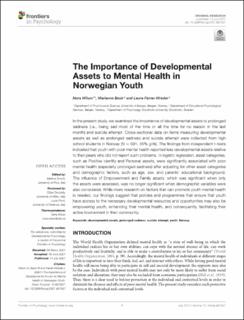| dc.description.abstract | In the present study, we examined the importance of developmental assets to prolonged sadness (i.e., being sad most of the time or all the time for no reason in the last month) and suicide attempt. Cross–sectional data on items measuring developmental assets as well as prolonged sadness and suicide attempt were collected from high school students in Norway (N = 591, 55% girls). The findings from independent t–tests indicated that youth with poor mental health reported less developmental assets relative to their peers who did not report such problems. In logistic regression, asset categories, such as Positive identity and Personal assets, were significantly associated with poor mental health (especially prolonged sadness) after adjusting for other asset categories and demographic factors, such as age, sex, and parents' educational background. The influence of Empowerment and Family assets, which was significant when only the assets were assessed, was no longer significant when demographic variables were also considered. While more research on factors that can promote youth mental health is needed, our findings suggest that policies and programmes that ensure that youth have access to the necessary developmental resources and opportunities may also be empowering youth, enhancing their mental health, and consequently, facilitating their active involvement in their community. | en_US |

